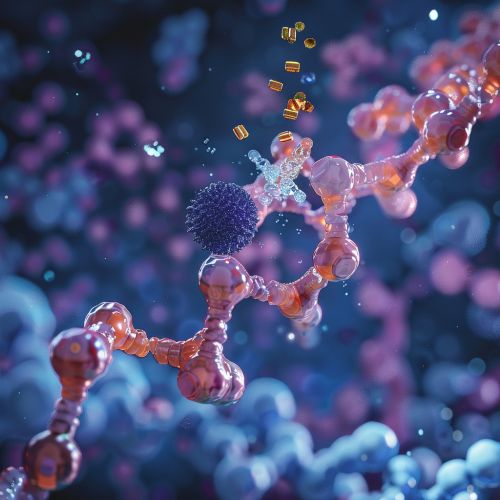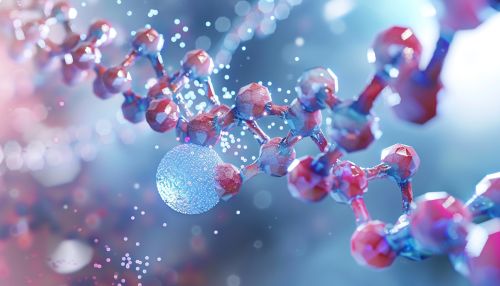Cytochrome P450
Introduction
Cytochrome P450 (CYP450) is a large and diverse group of enzymes that play a crucial role in the metabolism of various substances within the body. These enzymes are primarily found in the liver and are involved in the oxidation of organic substances. Cytochrome P450 enzymes are essential for the metabolism of drugs, the synthesis of cholesterol, steroids, and other lipids, and the detoxification of foreign chemicals.
Structure and Function
Cytochrome P450 enzymes are heme-containing proteins that catalyze the oxidation of organic substrates. The heme group, which contains an iron atom, is the active site of the enzyme and is responsible for the enzyme's catalytic activity. The name "cytochrome P450" is derived from the fact that these enzymes exhibit a characteristic absorbance peak at 450 nm when bound to carbon monoxide.
The primary function of CYP450 enzymes is to introduce an oxygen atom into the substrate molecule, a process known as monooxygenation. This reaction typically results in the formation of a hydroxyl group, which can increase the solubility of the substrate and facilitate its excretion from the body. The general reaction catalyzed by CYP450 enzymes can be represented as follows:
RH + O2 + NADPH + H+ → ROH + H2O + NADP+
Isoforms and Genetic Variability
There are more than 50 different CYP450 enzymes in humans, each encoded by a different gene. These enzymes are classified into families and subfamilies based on their amino acid sequence similarities. The most well-studied families include CYP1, CYP2, and CYP3, which are primarily involved in drug metabolism.
Genetic polymorphisms in CYP450 genes can lead to significant variability in enzyme activity among individuals. These polymorphisms can result in differences in drug metabolism rates, which can affect drug efficacy and the risk of adverse effects. For example, individuals with certain polymorphisms in the CYP2D6 gene may metabolize drugs more slowly or more rapidly than the general population, leading to variations in drug response.
Role in Drug Metabolism
Cytochrome P450 enzymes are responsible for the metabolism of a wide range of drugs, including many commonly used medications. The enzymes can either activate or deactivate drugs, depending on the specific substrate and the type of reaction catalyzed. The metabolism of drugs by CYP450 enzymes can be divided into two phases:
Phase I Metabolism
Phase I metabolism involves the introduction of functional groups into the drug molecule, typically through oxidation, reduction, or hydrolysis reactions. Cytochrome P450 enzymes are the primary catalysts of Phase I reactions, which can result in the formation of more polar and water-soluble metabolites. These metabolites may be pharmacologically active or inactive.
Phase II Metabolism
Phase II metabolism involves the conjugation of the drug or its Phase I metabolites with endogenous molecules, such as glucuronic acid, sulfate, or glutathione. These conjugation reactions are catalyzed by enzymes such as UDP-glucuronosyltransferase and sulfotransferase. The resulting conjugates are usually more water-soluble and can be more easily excreted from the body.
Clinical Implications
The activity of CYP450 enzymes can be influenced by various factors, including genetic polymorphisms, drug interactions, and environmental factors. Understanding these factors is crucial for optimizing drug therapy and minimizing the risk of adverse effects.
Genetic Polymorphisms
As mentioned earlier, genetic polymorphisms in CYP450 genes can lead to variability in enzyme activity. For example, individuals with certain polymorphisms in the CYP2C19 gene may have reduced or absent enzyme activity, which can affect the metabolism of drugs such as clopidogrel and omeprazole. Pharmacogenetic testing can help identify individuals with these polymorphisms and guide personalized drug therapy.
Drug Interactions
Cytochrome P450 enzymes are involved in the metabolism of many drugs, and the concurrent use of multiple medications can lead to drug interactions. These interactions can result in altered drug metabolism, leading to changes in drug levels and potential adverse effects. For example, ritonavir, a protease inhibitor used in the treatment of HIV, is a potent inhibitor of CYP3A4 and can increase the levels of other drugs metabolized by this enzyme.
Environmental Factors
Environmental factors, such as diet, smoking, and exposure to chemicals, can also influence CYP450 enzyme activity. For example, grapefruit juice contains compounds that can inhibit CYP3A4, leading to increased levels of drugs metabolized by this enzyme. Similarly, smoking can induce the activity of certain CYP450 enzymes, such as CYP1A2, which can affect the metabolism of drugs like theophylline.
Applications in Biotechnology and Medicine
Cytochrome P450 enzymes have numerous applications in biotechnology and medicine. They are used in drug development, environmental bioremediation, and the synthesis of valuable chemicals.
Drug Development
CYP450 enzymes are used in drug development to study the metabolism and potential interactions of new drug candidates. In vitro assays using recombinant CYP450 enzymes can help predict how a drug will be metabolized in the body and identify potential drug interactions. This information is crucial for optimizing drug dosing and minimizing the risk of adverse effects.
Environmental Bioremediation
Cytochrome P450 enzymes can be used in environmental bioremediation to degrade pollutants and toxic chemicals. Certain CYP450 enzymes have the ability to oxidize and detoxify environmental contaminants, such as polycyclic aromatic hydrocarbons and polychlorinated biphenyls. These enzymes can be engineered and expressed in microorganisms to enhance their bioremediation capabilities.
Synthesis of Valuable Chemicals
CYP450 enzymes are used in the synthesis of valuable chemicals, such as pharmaceuticals, agrochemicals, and natural products. The enzymes can catalyze a wide range of chemical reactions, including hydroxylation, epoxidation, and demethylation. By engineering CYP450 enzymes with desired properties, researchers can develop biocatalysts for the efficient and selective synthesis of complex molecules.
Future Directions
The study of cytochrome P450 enzymes continues to be an active area of research, with ongoing efforts to better understand their structure, function, and regulation. Advances in structural biology, genomics, and bioinformatics are providing new insights into the mechanisms of CYP450 enzymes and their role in human health and disease.
Structural Biology
Recent advances in structural biology techniques, such as X-ray crystallography and cryo-electron microscopy, have provided detailed insights into the three-dimensional structures of CYP450 enzymes. These structural studies are helping to elucidate the molecular mechanisms of enzyme catalysis and substrate recognition, which can inform the design of new drugs and biocatalysts.
Genomics and Bioinformatics
The advent of high-throughput sequencing technologies has enabled the identification of new CYP450 genes and the characterization of their genetic variability. Bioinformatics tools are being used to analyze the sequences and predict the functions of CYP450 enzymes. These approaches are helping to uncover the diversity and evolutionary history of the CYP450 enzyme family.
Personalized Medicine
The integration of pharmacogenomics into clinical practice is paving the way for personalized medicine, where drug therapy is tailored to an individual's genetic makeup. Understanding the genetic variability of CYP450 enzymes and their impact on drug metabolism can help optimize drug dosing and reduce the risk of adverse effects. Pharmacogenetic testing is becoming increasingly available and is expected to play a larger role in clinical decision-making.
Conclusion
Cytochrome P450 enzymes are a vital component of the body's metabolic machinery, playing a key role in the metabolism of drugs, the synthesis of important biomolecules, and the detoxification of foreign chemicals. The study of these enzymes has important implications for drug development, personalized medicine, and biotechnology. Ongoing research is providing new insights into the structure, function, and regulation of CYP450 enzymes, with the potential to improve human health and advance various biotechnological applications.


